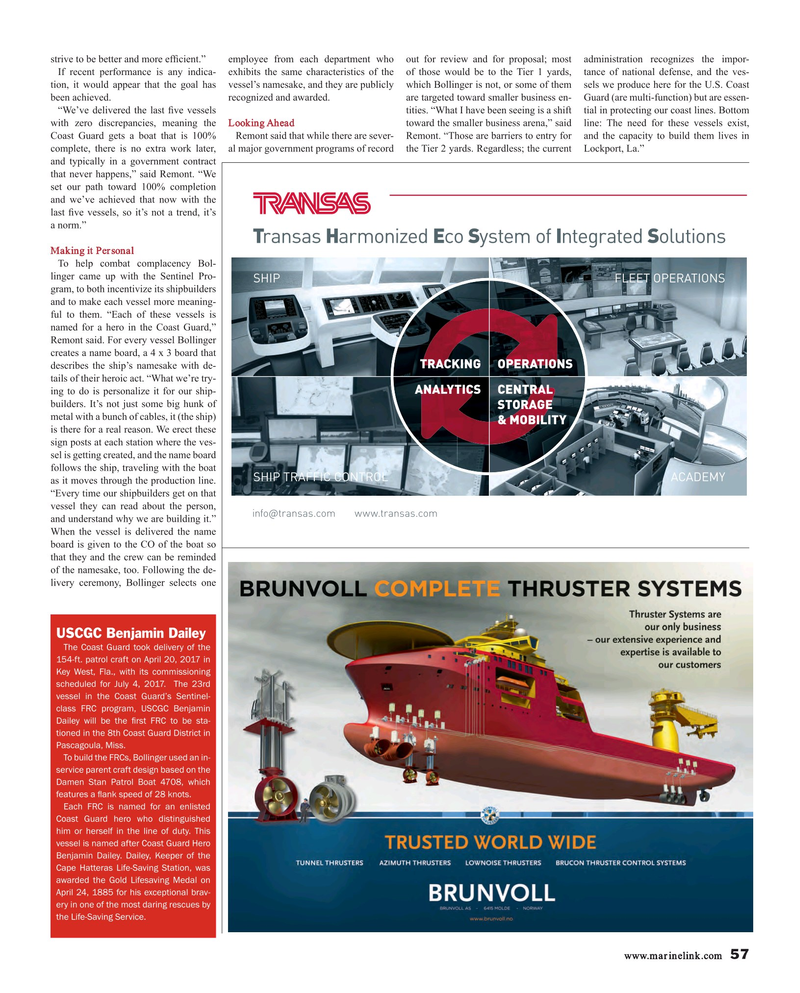
Page 57: of Maritime Reporter Magazine (May 2017)
The Marine Propulsion Edition
Read this page in Pdf, Flash or Html5 edition of May 2017 Maritime Reporter Magazine
strive to be better and more ef? cient.” employee from each department who out for review and for proposal; most administration recognizes the impor-
If recent performance is any indica- exhibits the same characteristics of the of those would be to the Tier 1 yards, tance of national defense, and the ves- tion, it would appear that the goal has vessel’s namesake, and they are publicly which Bollinger is not, or some of them sels we produce here for the U.S. Coast been achieved. recognized and awarded. are targeted toward smaller business en- Guard (are multi-function) but are essen- “We’ve delivered the last ? ve vessels tities. “What I have been seeing is a shift tial in protecting our coast lines. Bottom with zero discrepancies, meaning the Looking Ahead toward the smaller business arena,” said line: The need for these vessels exist,
Coast Guard gets a boat that is 100% Remont said that while there are sever- Remont. “Those are barriers to entry for and the capacity to build them lives in complete, there is no extra work later, al major government programs of record the Tier 2 yards. Regardless; the current Lockport, La.” and typically in a government contract that never happens,” said Remont. “We set our path toward 100% completion and we’ve achieved that now with the last ? ve vessels, so it’s not a trend, it’s a norm.”
Making it Personal
To help combat complacency Bol- linger came up with the Sentinel Pro- gram, to both incentivize its shipbuilders and to make each vessel more meaning- ful to them. “Each of these vessels is named for a hero in the Coast Guard,”
Remont said. For every vessel Bollinger creates a name board, a 4 x 3 board that describes the ship’s namesake with de- tails of their heroic act. “What we’re try- ing to do is personalize it for our ship- builders. It’s not just some big hunk of metal with a bunch of cables, it (the ship) is there for a real reason. We erect these sign posts at each station where the ves- sel is getting created, and the name board follows the ship, traveling with the boat as it moves through the production line. “Every time our shipbuilders get on that vessel they can read about the person, and understand why we are building it.”
When the vessel is delivered the name board is given to the CO of the boat so that they and the crew can be reminded of the namesake, too. Following the de- livery ceremony, Bollinger selects one
USCGC Benjamin Dailey
The Coast Guard took delivery of the 154-ft. patrol craft on April 20, 2017 in
Key West, Fla., with its commissioning scheduled for July 4, 2017. The 23rd vessel in the Coast Guard’s Sentinel- class FRC program, USCGC Benjamin
Dailey will be the ? rst FRC to be sta- tioned in the 8th Coast Guard District in
Pascagoula, Miss.
To build the FRCs, Bollinger used an in- service parent craft design based on the
Damen Stan Patrol Boat 4708, which features a ? ank speed of 28 knots.
Each FRC is named for an enlisted
Coast Guard hero who distinguished him or herself in the line of duty. This vessel is named after Coast Guard Hero
Benjamin Dailey. Dailey, Keeper of the
Cape Hatteras Life-Saving Station, was awarded the Gold Lifesaving Medal on
April 24, 1885 for his exceptional brav- ery in one of the most daring rescues by the Life-Saving Service.
www.marinelink.com 57
MR #5 (50-57).indd 57 MR #5 (50-57).indd 57 5/5/2017 1:41:09 PM5/5/2017 1:41:09 PM

 56
56

 58
58
